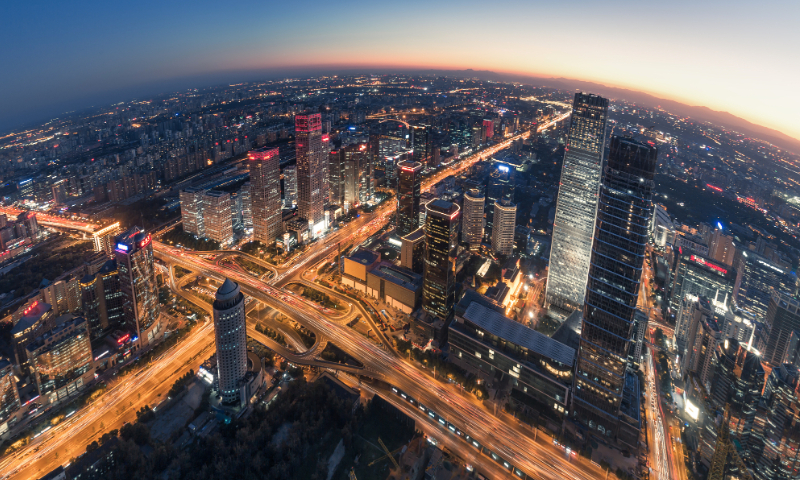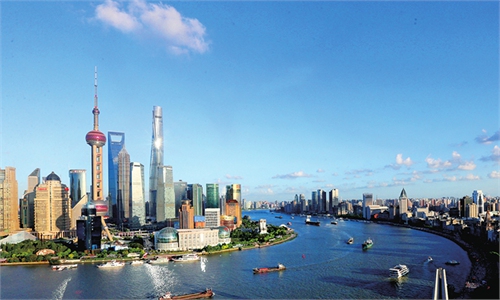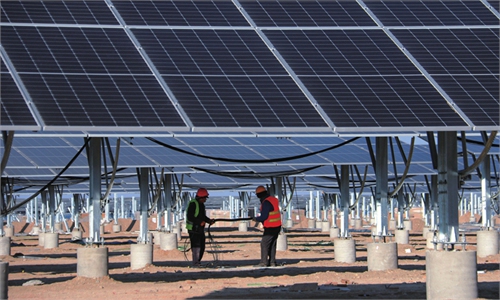
Beijing CBD Photo: VCG
China's economy staged an impressive turnaround in May, as a set of better-than-expected official data released on Wednesday pointed to improvements in several crucial economic indicators, including industrial output, fixed-asset investment and retail sales, further highlighting the resilience of the Chinese economy against challenges posed by the COVID-19 even as Western economies are facing mounting downward pressure.
The improved economic activity in May is expected to pick up further in June, underpinned by the implementation of broad-based pro-growth measures, according to the country's top statistical bureau, whose data show that the economy is heading toward reasonable growth in the second quarter.
In a fresh sign of policy support, a State Council executive meeting on Wednesday stressed endorsing private investment and expanding effective investment to spur consumption and employment.
Data robustness sets the stage for the economy to bottom out in the current quarter before gaining stream in the second half of the year, economists said. They put China's full-year growth at around 5 percent - an enviable growth rate that is set to dwarf other major economies that have taken the COVID-19 "lying flat" and face major economic woes - notably the US, whose economy will likely return to contraction in the wake of sharper rate hikes.
Impressive turnaround
The country's industrial output expanded 0.7 percent year-on-year, while urban fixed-asset investment was up 6.2 percent in the first five months, data from the National Bureau of Statistics (NBS) showed Wednesday, indicating strong economic resilience after Omicron flare-ups dealt a heavier-than-expected blow to the economy throughout April.
By comparison, industrial production contracted by 2.9 percent in April.
In another sign of a turnaround, urban fixed-asset investment edged up 0.72 percent in May over April, NBS data showed.
"With the gradual stabilization of the economy through epidemic control and policy implementation, companies and factories have been accelerating resumption, resulting in apparent manufacturing improvement in epidemic-hit regions, including the Yangtze River Delta and the Northeast China provinces," Fu Linghui, spokesperson for the NBS, told a press briefing in Beijing on Wednesday.
In May, the industrial output of major firms in the two virus-inflicted regions fell 3.2 percent and 1.1 percent, respectively, narrowing by more than 10 percentage points compared with April.
Meanwhile, consumption, a major growth driver, also showed improving signs despite contraction. Retail sales, a main gauge of consumption, contracted 6.7 percent in May, better than a 11.1 percent fall in April, per NBS statistics.
The impressive figures released on Wednesday added to the excitement from previously published figures measuring manufacturing activity, goods trade and credit growth, which had pointed to a brighter-than-expected economic landscape.
"The remarkable improvement in macro-economic indexes is an encouraging signal that China's economy has embarked on a faster-than-expected track to recovery," Tian Yun, former vice director of the Beijing Economic Operation Association, told the Global Times on Wednesday.
Buoyed by the brighter economic indicators, Chinese stocks posted gains across the board on Wednesday, with the flagship Shanghai Composite Index closing up 0.5 percent to 3305.41.
Hong Kong's benchmark Hang Seng Index jumped 1.14 percent to stay well above 21,000 points.
With a slew of favorable figures signaling that the worst might have been over, there's sufficient hope that the economy is on course for reasonable growth in the second quarter before gaining steam over the next two quarters despite lingering uncertainties both at home and abroad.
"The economic operation is expected to continue improving in June along with the implementation of policy measures aimed at stabilizing growth," Fu said.
Major economic data including industrial output, consumption and foreign trade are expected to further improve throughout the year, Zhou Maohua, a macroeconomic analyst at Everbright Bank, told the Global Times on Wednesday.
It is expected that industrial production will recover significantly with measures aimed at unclogging the supply chain and relief measures on enterprise, Zhou said, adding that electrical consumption in May has already shown positive signs of industrial production.
Zhou predicted consumption would pick up further later this year, driven by the pent-up demand earlier suppressed by the epidemic, and also by the consumption stimulus announced in different regions aimed at boosting consumption.
A nationwide push for car purchases is seen as adding fuel to a consumption revival for the remainder of the year.
The country's foreign trade will continue to maintain a high momentum throughout the year due to high global inflation and supportive policies on the export sector, the analyst said.
The impressive May data could be attributed to a fast rollout of support policies, Li Chang'an, a professor at the Academy of China Open Economy Studies of the University of International Business and Economics, told the Global Times on Wednesday.
Special-purpose bonds further drove up investment in May, while industrial output recovered faster in the month compared to April, Li said.
Since late April, several central government meetings, primarily focusing on stabilizing growth and market entities and ensuring employment, were held to shore up the economy.
Targeted policies from tax cuts to consumption vouchers and support policies for market entities have been announced by central and local authorities, which analysts said had effectively and promptly shored up market confidence and stabilized prospects.
China still global powerhouse
The convincing revival of the economy in May would continue in the coming quarters, setting China apart from those obsessed with the "lying flat" mentality against the Omicron virus such as the US and the UK, observers stressed.
If the epidemic can be effectively put under control, adding to the effectiveness of multiple pro-growth measures, China's economy is expected to achieve reasonable growth in the second quarter, the NBS spokesperson estimated.
Ongoing virus containment efforts in Beijing have shown that the country has opted for a more targeted approach to stopping the Omicron spread, minimizing the impact on the economy of the anti-virus push.
Second-quarter growth could still reach 5 percent, with accelerated efforts landing on the ground in June, with inspectors from the central government overseeing their implementation, and local governments working on them, Li said. He noted that with strong political will of the central government, the Chinese economy still stands a chance of leaping to the stated target of 5.5 percent annual growth.
"Based on the current recovery pace, it is expected China's economy could grow by more than 2 percent in the second quarter and reach around 5 percent for the year," Tian said.
China's GDP grew by 4.8 percent in the first quarter of 2022.
While the Chinese economy will experience a U-turn after it has contained the epidemic and stabilized economic growth, Western countries, which "have laid flat" in fighting Omicron, are likely to face sharp downward economic pressure this year and even negative growth, experts said, speaking highly of China's continued role as a global economic powerhouse.
"GDP growth in the US could be more than 2 percent in the second quarter, maybe a little higher than that of China. However, the US economic outlook is on a downward trend due to its surging inflation, which has put the Fed on track for more big rate hikes," Tian said. "If the US implements a radical rate hike, it is possible the US economy will contract in the third and the fourth quarter."
The UK economy, for its part, shrank 0.3 percent in April as its monthly GDP fell for the second consecutive month, pointing to sluggishness that has gripped the Western economy at large.



